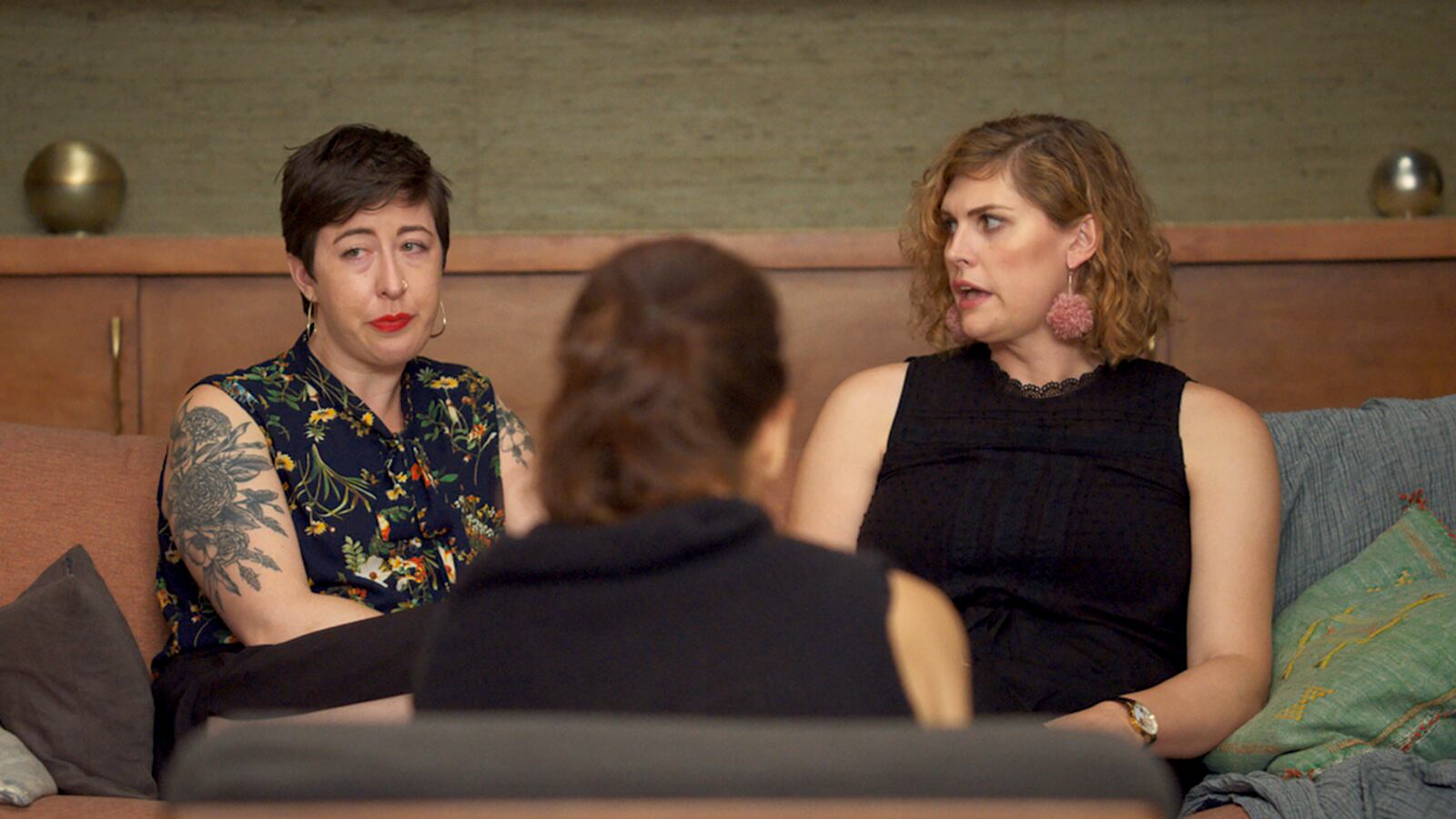One night last week, I spent several hours on my couch going to town on a wheel of cheese while watching couples fight.
Mau wants a spicy, on-demand sex life with Annie, his wife of 23 years, though the dominatrix-themed threesome that she had planned for his birthday is NOT what he had in mind, thank you—and, no, he is NOT being unreasonable in saying that.
Elaine is not pleased that, after 11 years of marriage, DeSean has pulled away and stopped giving her the attention she needs. But Elaaaaaine, you’re just too needy, DeSean protests. Who has the energy?
Sarah and Lauren, her trans wife of two years, always had a plan for when they were going to have kids. But Sarah has upped her timeline to, well, right-now-this-very-second, and it’s exposing all the cracks in their relationship.
And don’t even get me started about Evelyn and Alan, who six years into marriage have some of the most egregious trust issues I’ve ever seen and quite frankly, Evelyn, you don’t seem to like him very much anyway.
Nearly an entire box of crackers and intense dairy indigestion later, I was living my nosy-bitch fantasy.
Last Friday, timed with the premiere episode’s debut, Showtime had made the entire series of Couples Therapy available for binging on-demand and on the Showtime streaming platforms.
For four-and-a-half hours, I watched these couples bitterly fight, cry, make up, weep, accuse, betray, confess, connect, sob, shout, laugh, reminisce, and put it all on the line—as in their marriages—in raw, very real therapy sessions.
Guiding them through was Orna Guralnik, a New York City-based clinical psychologist and psychoanalyst. With her permanently perched eyebrows, unplaceable accent, and lean, incessantly folded frame, Dr. Guralnik could not be more perfectly cast. Her expressive hands, God’s Gifts to Gesticulation, swirl through the air, gestures that complete leading, half-finished sentences—“And that made you feel…”—in fantastic therapist-y fashion.
But Guralnik isn’t “cast” in the way we normally associate that word, nor are the couples baring their deepest, darkest truths to her. She is a real therapist, and they are couples really seeking help.
Couples Therapy is a voyeur’s dream, extreme titillation for anyone who has never met a closed door they didn’t want to go directly behind. I am obsessed, and, gauging by social-media comments from those who have also discovered Couples Therapy, so are a lot of people. You’re about to be, as well. So we had a little therapy session of our own, with filmmakers Josh Kriegman and Elyse Steinberg (Weiner), who created the show with Eli Despres, to talk about why it’s all so fascinating.
First on the agenda: How uncomfortable should we feel while watching? It’s juicy stuff. But it’s all so intimate and ugly, kind of making your skin crawl. Within 15 seconds of meeting each couple, you demand they break up. By the end of each episode, you want these crazy kids to figure it out and make a hearty go of it. It’s... a lot!
“People are going to have a wide range of reaction to this,” Kriegman says. “These are real people who are struggling and fighting for their relationships.” Adds Steinberg, “I think there is some comfort in seeing these struggles and identifying with them personally, making a connection [with the couples].”
Seeds of the idea for the series sprouted when the duo was working on Weiner, the 2016 documentary chronicling disgraced former politician Anthony Weiner’s New York City mayoral campaign, and what it all said about politics, sex, media, and, most fascinating to armchair looky-loos like me, his marriage to political operative Huma Abedin. We had all wondered, despite it not being any of our damn business: How could she stay with him?
“What was going on there was more nuanced than it appeared in the headlines,” Kriegman says. “The real dynamics of a relationship is always more complicated than it appears. With this show, you get to see the relationships from the inside.”
Both of Kriegman’s parents are therapists. A New Yorker herself, Steinberg is very familiar with the world of therapy, but, more specifically, the reality of it, too. The way therapy had been depicted in the world and especially in pop culture and especially-especially on reality TV is sensationalized. They wanted to debunk those myths and show with authenticity the rawness of a couple going through the process.
The couples they cast have diverse backgrounds, gender and sexual identities, lengths of marriage, and certainly issues to work through. (We led with the crazy threesome anecdote, but there is some serious, rooted, painful stuff going on here.) The key was that they were already in the market for therapy before there was an opportunity to be filmed while doing it. In a genre of television where people tend to play things up for the cameras and what “real” actually means is a heightened version of real, that these couples would be honest and authentic was the biggest concern.
From a production standpoint, that meant creating an environment that felt like an actual therapist’s office. Cameras were concealed behind one-way glass, so that the couples wouldn’t be distracted by having equipment in their faces. The result is that they would arrive at the waiting room, have their one-hour sessions, and leave without having ever interacted with production or seeing a camera.
Couples Therapy, then, also doesn’t have the look or feel of other reality and documentary series we’ve become familiar with that explore love and relationships. There are no confessionals recapping drama or used to narrate how characters actually feel. Nothing seems as nakedly manufactured or produced as the reality, so to speak, of reality TV.
And at a time when you can’t change the channel without landing on a “non-fiction” series chronicling first dates and bachelors and bachelorettes and love on islands and seeking perfect matches or whatever a 90-day fiancé is, this show stands out. It’s rare to check in with couples who are years, even decades, into their own connection, which breeds its own, lived-in authenticity.

“Right now, we see a lot of curated versions of people on social media,” Steinberg says. “I think what we’re not talking about is the inner lives of the struggles we’re going through. Our hope is that this series can provide a reality check, that our struggles are all human and universal.”
It goes without saying that Couples Therapy is addicting. You shout at the TV. Elaine, what are you doing? You’re not happy! Next minute, it’s DeSean you’re rooting for. You’re rooting for them both, actually. At the ugliest moments, that means rooting for them to break up, too.
Kriegman and Steinberg are right. You do relate to their issues. You do see your struggles in their struggles. You do glare over at your partner sitting on the other side of the couch, recognizing that the beginnings of the same issues you’re seeing on screen are starting to fester in your own relationship. Horrifying!
Mostly, the series ends and you’re desperate to find each and every one of them and find out where they are now on their journeys, how they’re feeling.
“One of the things about our culture right now is that we’re inundated with stories of conflict and polarization,” Kriegman says. “The dominant narrative is one of people entrenched in their corners, digging their heels in, and really bracing for a fight. We were excited with this series to tell a different story. There may be some discomfort in watching. But ultimately these are stories of love and compassion and empathy.”


